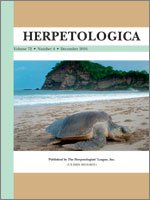Cane Toads (Rhinella marina) are introduced pests and have successfully invaded many locations. Their highly plastic reproductive activity might be one of the factors facilitating invasions. Previous studies of the reproductive cycle of this species collected toads from breeding areas, thus biasing samples to breeding individuals. To examine how toad reproductive condition changed through time, and its relationship to observed levels of breeding activity, we sampled toads from nonbreeding habitat over 2 yr, while observing breeding behavior at the nearest pond. Female and male toads were collected and dissected each month, and body mass, gonadal volume, and fat body mass were recorded. Mean gonadal volume of both female and male toads decreased over the breeding season and increased when toads were not breeding. Female reproductive condition was classified into early, middle, or late stages of egg development. The proportion of females with late-stage eggs slowly increased until the point in the breeding season when males started calling, and then decreased. The fat body mass cycle was roughly opposite to the gonadal cycle. The seasonal cycle in toad reproductive condition was correlated with rainfall, indicating that rainfall is one of the causes of variation in the timing of their reproduction. We suggest the highest capture rates of large females with fully mature eggs in traps would be obtained in the late dry to early wet seasons, up to the time when males start calling.
How to translate text using browser tools
1 December 2016
Seasonal Reproductive Cycles of Cane Toads and Their Implications for Control
Kiyomi Yasumiba,
Ross A. Alford,
Lin Schwarzkopf
ACCESS THE FULL ARTICLE

Herpetologica
Vol. 72 • No. 4
December 2016
Vol. 72 • No. 4
December 2016
breeding behavior
introduced species
ovarian cycle
reproductive biology
Rhinella
trapping




